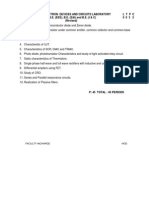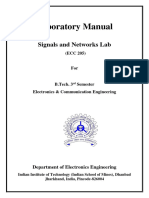EENG301L
EENG301L
Uploaded by
Omar SroujiCopyright:
Available Formats
EENG301L
EENG301L
Uploaded by
Omar SroujiCopyright
Available Formats
Share this document
Did you find this document useful?
Is this content inappropriate?
Copyright:
Available Formats
EENG301L
EENG301L
Uploaded by
Omar SroujiCopyright:
Available Formats
EENG301L
Electric Circuits Lab
Course Objectives ( This lab introduces experiments concerning designing, building, and
)اهداف المادة: testing DC and AC electric circuits which use resistors, capacitors,
inductors, transformers, and OP-AMP. The objectives of this course are
to: reinforce and complement the material covered in the course. It
enhances the technical abilities of the students by engaging them in
experiments that involves most common electric lab equipment such as
multimeter, function generator, DC source and oscilloscopes. Also, this
lab offers the ability to test electric circuits using schematics software
(Pspice). The lab concludes with designing applications on Filters and
OP-AMP.
Course Outcomes 1. Read, interpret and diagnose electric circuits using schematic/diagrams.
()مخرجات المادة: 2. Check applied voltages, circuit voltages, and voltage drops in electric
circuits using a digital multimeter, oscilloscope, function generator, and
DC power supply.
3. Check current flow in electrical circuits and components using an
ammeter.
4. Determine the characteristics of several electric elements such as
resistors, capacitors, inductors and transformers.
5. Write complete technical reports.
Covered Topics Experiments based on:
()محتوى المادة: 1. Fundamentals of DC and AC electric circuits.
2. Applications on Ohm’s and Kirchhoff’s laws, Superposition, Thevenin
and Norton Theorem.
3. Applications on transformers: structure, operation and losses.
4. Applications on R, C, L, RC, RL and RLC circuits.
5. Design of passive filters.
Course Schedule ()جدول تدريس المادة على مدار الفصل:
Week Chapter/Reference Topics
Lab Manual Experiment 1: Explanation of the Syllabus, Lab rules,
report's contents, color code: resistors, capacitor,
Week 1 Inductor
Lab Manual Experiment 2: Pspice
Ohm's law, Kirchhoff’s law, voltage and current
Week 2 dividers, Capacitors in DC Circuits.
Lab Manual Experiment 3: Breadboard
Week 3 Superposition principle, soldering
Week 4 Lab Manual Experiment 4: Breadboard
OP-Amp characteristics: DC Input bias current and
input offset current.
Lab Manual Experiment 5: Breadboard
OP-AMP Applications: Inverting and Non-Inverting OP-
Week 5 AMP
Lab Manual
Experiment 6: Breadboard
Thevenin, and Norton’s Theorems and maximum
Week 6 power transfer.
Lab Manual Experiment 7: Com3lab (Board-70013)
Principle of Induction and characteristics of
Week 7 Transformers.
Week 8 Lab Manual Project Submission
Lab Manual Experiment 8: Com3lab (Board-70013)
Week 9 Transformer Underload
Lab Manual Experiment 9: Com3lab (Board-70013)
Week 10 Transformer Losses
Lab Manual Experiment 10: Breadboard
Week 11 AC analysis of RC circuits
Lab Manual Experiment 11: Breadboard
Week 12 AC analysis of RL circuits
Lab Manual Experiment 12: Breadboard:
Week 13 RC Low and high pass filter
Lab Manual Experiment 13: Breadboard
Week 14 RLC Band pass and Band reject filter
Week 15 Lab Manual Final Exam
Assessment Methods & Grades Distribution ( )طرق التقييم وتوزيع الدرجات:
Assessment Weight (%)
Technical Evaluation 40%
Report one, Report two and Report three 10% each, 30% Total
Project 10%
Final Exam 20%
Textbook / References ()المراجع:
1. Leybold Didactic Master Unit, Version 9, Board No: 70011 DC1, 70012 DC2, 70013AC1, and
70014 AC2, Student manual book.
2. Albert Paul Malvino, William E. Long, Experiments for Electric Circuits Laboratory.
You might also like
- Taylor AffDocument4 pagesTaylor AffjerlogNo ratings yet
- 15Ee103L Electric Circuits Lab: Register No: Name of The Student: Semester: DepartmentDocument66 pages15Ee103L Electric Circuits Lab: Register No: Name of The Student: Semester: DepartmentArvind N LakshmananNo ratings yet
- Edc Lab-1 Manual-2Document91 pagesEdc Lab-1 Manual-2Ashish SharmaNo ratings yet
- 002-1-EE 111 Linear Circuit AnalysisDocument2 pages002-1-EE 111 Linear Circuit AnalysisBilal Hussain ShahNo ratings yet
- CA Solved Lab Manual (TC-19069)Document50 pagesCA Solved Lab Manual (TC-19069)Sohaib Waseem100% (2)
- 2008 Chennai LabDocument40 pages2008 Chennai Labsulthan_81No ratings yet
- Preamble: Laboratory Manual Power Electronics and SimulationDocument80 pagesPreamble: Laboratory Manual Power Electronics and SimulationDamodar Reddy MNo ratings yet
- Basic Electrical Laboratory EEL108A 19Document50 pagesBasic Electrical Laboratory EEL108A 19P SNo ratings yet
- ENA - Lab - Manual (Update 17-4-2019) PDFDocument76 pagesENA - Lab - Manual (Update 17-4-2019) PDFMuhammad SaadNo ratings yet
- ECL CourseDocument106 pagesECL CourseBÌNH TRẦN THANHNo ratings yet
- Modul Prak Elka 1Document12 pagesModul Prak Elka 1izhasepdianti123No ratings yet
- Applied Physics Lab JournalDocument50 pagesApplied Physics Lab JournalSahendraNo ratings yet
- Course Type of Course Catalog Description: Department of Electrical and Computer EngineeringDocument2 pagesCourse Type of Course Catalog Description: Department of Electrical and Computer EngineeringSaad MuftahNo ratings yet
- Electric Circuits Lab 15EE103L PDFDocument61 pagesElectric Circuits Lab 15EE103L PDFMadhavanInduNo ratings yet
- LIC LAB Manual PDFDocument86 pagesLIC LAB Manual PDFSandeep SNo ratings yet
- National University of Engineering Mechanical Engineering ProgramDocument3 pagesNational University of Engineering Mechanical Engineering ProgramJosé CorreaNo ratings yet
- Circuit AnalysisDocument46 pagesCircuit AnalysisSaleem SonuNo ratings yet
- Faculty MemberDocument7 pagesFaculty MemberMuhammad FahadNo ratings yet
- PE Lab ManualDocument95 pagesPE Lab ManualSureshNo ratings yet
- Complete LICA Lab ManualDocument54 pagesComplete LICA Lab Manualnuthan9150% (2)
- Beee Lab Manual-2020Document99 pagesBeee Lab Manual-2020venkata karthikNo ratings yet
- Nas LabDocument89 pagesNas LabJayaprasadGollaNo ratings yet
- Institute of Industrial Electronics Engineering, (Pcsir) KarachiDocument11 pagesInstitute of Industrial Electronics Engineering, (Pcsir) KarachiQuratulain AnwarNo ratings yet
- EEW Lab Manual - FinalDocument51 pagesEEW Lab Manual - FinaljeniferNo ratings yet
- ELE001 - Basic Electricity and ElectronicsDocument4 pagesELE001 - Basic Electricity and ElectronicsHarold LuceroNo ratings yet
- 2023 - ELNC 6010 Course Outline 4Document3 pages2023 - ELNC 6010 Course Outline 4dntjgpvjd5No ratings yet
- EES512 Course OutlineDocument7 pagesEES512 Course OutlineDildar Khan BhatiNo ratings yet
- LAB With Experiments DetailsDocument14 pagesLAB With Experiments DetailsMohd Helmy Hakimie RozlanNo ratings yet
- Iec Lab - Exp 06 - Fall 23-24Document5 pagesIec Lab - Exp 06 - Fall 23-24rakibulislamakash400% (1)
- Electric Circuits: Lab Manual Experiment No 8Document6 pagesElectric Circuits: Lab Manual Experiment No 8usamaNo ratings yet
- Basic Electrical and Elctronics Engineering Laboratory Lab ManualDocument33 pagesBasic Electrical and Elctronics Engineering Laboratory Lab ManualAnanay ChahalNo ratings yet
- Lic Syllabus 4th SemDocument4 pagesLic Syllabus 4th SemYo Yo AnandNo ratings yet
- American International University-Bangladesh: Title: Ramp Control of A Single Phase Half Converter AbstractDocument3 pagesAmerican International University-Bangladesh: Title: Ramp Control of A Single Phase Half Converter AbstractCarry GamingNo ratings yet
- Front Page PE Lab1Document6 pagesFront Page PE Lab1ganeshmegce_36600295No ratings yet
- Laboratory Manual For Ac Electrical CircuitsDocument90 pagesLaboratory Manual For Ac Electrical CircuitsLharie Mae BecinaNo ratings yet
- Iec Lab Exp 06Document5 pagesIec Lab Exp 06esumshunNo ratings yet
- Laboratory Manual For Ac Electrical CircuitsDocument80 pagesLaboratory Manual For Ac Electrical CircuitsAngelo Palaming100% (1)
- Experiment No. 10: Single Phase Ac ControllerDocument9 pagesExperiment No. 10: Single Phase Ac ControllerMD.Minhazul Islam ShazedNo ratings yet
- Experiment No. 03: Single Phase Half & Full-Wave Controlled RectifierDocument6 pagesExperiment No. 03: Single Phase Half & Full-Wave Controlled RectifierMD.Minhazul Islam ShazedNo ratings yet
- EEE141 Course OutlineDocument5 pagesEEE141 Course OutlineLittle WizardNo ratings yet
- EE-153 IEE Lab Manual Jan 2022Document71 pagesEE-153 IEE Lab Manual Jan 2022Maqsood Ahmad KhanNo ratings yet
- Basics of Electrical and Electronics Engineering SEM - IDocument4 pagesBasics of Electrical and Electronics Engineering SEM - IohhNo ratings yet
- Na Lab ManualDocument91 pagesNa Lab ManualKiranmai KonduruNo ratings yet
- Lab1 Electric Circuits PDFDocument8 pagesLab1 Electric Circuits PDFBasel Abu Al-SoudNo ratings yet
- Iec Exp 10 Student ManualDocument3 pagesIec Exp 10 Student ManualprinceiutNo ratings yet
- Electronics Devices and Circuits LabDocument3 pagesElectronics Devices and Circuits LabsamactrangNo ratings yet
- ECE209 Lab3 ManualDocument17 pagesECE209 Lab3 ManualmixilopotstlyNo ratings yet
- PH705 Laboratory ManualDocument75 pagesPH705 Laboratory ManualSrikar MadhunapantulaNo ratings yet
- EEE 101L Lab ManualDocument40 pagesEEE 101L Lab ManualAzizNo ratings yet
- Laboratory No.1 Ohms Law and Kirchhoffs LawsDocument8 pagesLaboratory No.1 Ohms Law and Kirchhoffs LawsmausalataiNo ratings yet
- L209 EE435 Industrial ElectronicsDocument2 pagesL209 EE435 Industrial Electronicslnn97No ratings yet
- Power ElectronicsDocument6 pagesPower ElectronicsTushar RathoreNo ratings yet
- A Trick and Think Approach To A Second Order Circuit LabDocument9 pagesA Trick and Think Approach To A Second Order Circuit LabShanza GulNo ratings yet
- Lab Manual BEEE DR RDDocument76 pagesLab Manual BEEE DR RDJohn WickNo ratings yet
- EE103/EE203: Basic Electrical Engineering LTPC: (3-1-2) 5Document3 pagesEE103/EE203: Basic Electrical Engineering LTPC: (3-1-2) 5raghvendraprasadNo ratings yet
- ECC305 Signals and Networks LabDocument39 pagesECC305 Signals and Networks LabMridul GhoshNo ratings yet
- AC Electrical Circuits Lab Manual 123Document98 pagesAC Electrical Circuits Lab Manual 123xyzzyzNo ratings yet
- EEE 322 - 1 Course OutlineDocument5 pagesEEE 322 - 1 Course OutlineUmarSaboBabaDoguwaNo ratings yet
- Schaum's Outline of Basic Circuit Analysis, Second EditionFrom EverandSchaum's Outline of Basic Circuit Analysis, Second EditionRating: 5 out of 5 stars5/5 (18)
- Lebanese International University School of EngineeringDocument25 pagesLebanese International University School of EngineeringOmar SroujiNo ratings yet
- Lebanese International University School of Engineering: Department of Engineering Electric Circuits Lab EENG301LDocument14 pagesLebanese International University School of Engineering: Department of Engineering Electric Circuits Lab EENG301LOmar SroujiNo ratings yet
- Lebanese International University School of EngineeringDocument12 pagesLebanese International University School of EngineeringOmar SroujiNo ratings yet
- Lebanese International University School of Engineering: (5 Points)Document13 pagesLebanese International University School of Engineering: (5 Points)Omar SroujiNo ratings yet
- API 510 Final Model Exam-Open Book Page 1 of 6Document6 pagesAPI 510 Final Model Exam-Open Book Page 1 of 6jay2kay5793No ratings yet
- Introduction To Work StudyDocument29 pagesIntroduction To Work StudyJaysonJavier100% (1)
- Material Specification Comparison ChecklistDocument1 pageMaterial Specification Comparison Checklistgusloh0% (1)
- Mid Term Assesment 2020Document4 pagesMid Term Assesment 2020Ahmad AliNo ratings yet
- Physics ICSE Class X - Sample PaperDocument8 pagesPhysics ICSE Class X - Sample PaperApaNo ratings yet
- PLC S7 Diagnostics ET200MDocument2 pagesPLC S7 Diagnostics ET200MDanu Maldino100% (1)
- MPOB - BBA - Part 1Document40 pagesMPOB - BBA - Part 1Vaibhav guptaNo ratings yet
- 01B - Access Control - ACM Goldbridge - Catalogue and VIP Distributor Price List 21.09.01Document20 pages01B - Access Control - ACM Goldbridge - Catalogue and VIP Distributor Price List 21.09.01Monir BoumlikNo ratings yet
- On The OneDocument13 pagesOn The OneritchoNo ratings yet
- Automation and Monitoring For Aquaponic System BasDocument11 pagesAutomation and Monitoring For Aquaponic System BaslaurestadryxNo ratings yet
- Workforce PlanningDocument2 pagesWorkforce PlanningKrung KrungNo ratings yet
- Hygge Style Infographics by SlidesgoDocument34 pagesHygge Style Infographics by Slidesgodieplinh nguyenNo ratings yet
- Hcd-dx155, Dx255 SMDocument92 pagesHcd-dx155, Dx255 SMDogtamer100% (1)
- Trinitron Color TV KV-27V40Document72 pagesTrinitron Color TV KV-27V40Cristian LiNo ratings yet
- Sources of KnowledgeDocument2 pagesSources of KnowledgemariusznguyenNo ratings yet
- Student EngagementDocument16 pagesStudent EngagementP. HarrisonNo ratings yet
- 8612 Assignment 1 Ali Faizur RehmanDocument13 pages8612 Assignment 1 Ali Faizur RehmanAli Faizur RehmanNo ratings yet
- Material Selection 2Document7 pagesMaterial Selection 2NathanNo ratings yet
- Autoship Manual 10Document162 pagesAutoship Manual 10George PonpykaNo ratings yet
- 7310 20 MkiiDocument2 pages7310 20 MkiiDEYNERNo ratings yet
- Measuring Paint Film Thickness On Grit Blasted Steel ISO 2808 and Its EffectsDocument4 pagesMeasuring Paint Film Thickness On Grit Blasted Steel ISO 2808 and Its EffectsCarlos Nombela Palacios100% (1)
- Class 10 Economics Ch-4Document9 pagesClass 10 Economics Ch-4ATL Project AcademyNo ratings yet
- Report of Landfill in MichiganDocument67 pagesReport of Landfill in MichiganAndre SuitoNo ratings yet
- Overseer's Operation Handbook 1.1Document20 pagesOverseer's Operation Handbook 1.1Monday Night Tabletop100% (1)
- Land Rules and Regulations - OkDocument35 pagesLand Rules and Regulations - OkJEAN DE DIEU MUVARANo ratings yet
- JPSP 2022 347 1Document12 pagesJPSP 2022 347 1FabeNo ratings yet
- Mep Spa Reana Del Rojale Mini Syntax 16Document127 pagesMep Spa Reana Del Rojale Mini Syntax 16Anca PîrvanNo ratings yet
- Villa Savoye: Architecture & Town Planning Assignment#2Document8 pagesVilla Savoye: Architecture & Town Planning Assignment#2Hassan Ali SadiqNo ratings yet
- Statements 6792Document4 pagesStatements 6792muchas guataNo ratings yet





























































































